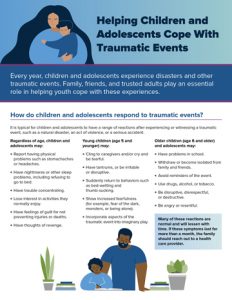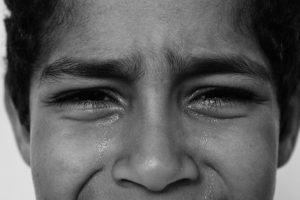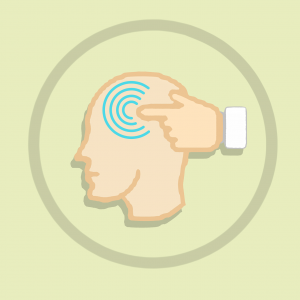California Law Puts a Suicide Hotline Number on School ID Cards
 California high school and middle school students will have some lifesaving information at their fingertips as they go back to school this year. Read more ›
California high school and middle school students will have some lifesaving information at their fingertips as they go back to school this year. Read more ›
 California high school and middle school students will have some lifesaving information at their fingertips as they go back to school this year. Read more ›
California high school and middle school students will have some lifesaving information at their fingertips as they go back to school this year. Read more ›
 Each year, children and adolescents experience disasters and other traumatic events. Parents, rescue workers, and members of the larger community can help children start the process of recovery and overcome these experiences. Read more ›
Each year, children and adolescents experience disasters and other traumatic events. Parents, rescue workers, and members of the larger community can help children start the process of recovery and overcome these experiences. Read more ›
 As a parent or caregiver, you want the best for your children or other dependents. You may be concerned or have questions about certain behaviors they exhibit and how to ensure they get help. Read more ›
As a parent or caregiver, you want the best for your children or other dependents. You may be concerned or have questions about certain behaviors they exhibit and how to ensure they get help. Read more ›
 In May 2019 at its annual Lifesavers Gala, the American Foundation for Suicide Prevention gave 49er Solomon Thomas and his parents the Survivors of Loss Award, an honor in recognition of those who have shared their stories in an effort to help others, advance prevention initiatives and create change. Read more ›
In May 2019 at its annual Lifesavers Gala, the American Foundation for Suicide Prevention gave 49er Solomon Thomas and his parents the Survivors of Loss Award, an honor in recognition of those who have shared their stories in an effort to help others, advance prevention initiatives and create change. Read more ›
 Recent research published in the Journal of the American Medical Association indicates the suicide rate for teens ages 15 to 19 is at its highest point in 20 years, and that suicide is now the second-leading cause of death for that age group. Read more ›
Recent research published in the Journal of the American Medical Association indicates the suicide rate for teens ages 15 to 19 is at its highest point in 20 years, and that suicide is now the second-leading cause of death for that age group. Read more ›
 For one week in the spring, KQED opens its airwaves to student-produced content from classrooms around the Bay Area in a segment called Youth Takeover. Read more ›
For one week in the spring, KQED opens its airwaves to student-produced content from classrooms around the Bay Area in a segment called Youth Takeover. Read more ›
 The Netflix show “13 Reasons Why” was associated with a 28.9% increase in suicide rates among U.S. youth ages 10-17 in the month (April 2017) following the show’s release, after accounting for ongoing trends in suicide rates, according to a study published in Journal of the American Academy of Child and Adolescent Psychiatry. The findings highlight the necessity of using best practices when portraying suicide in popular entertainment and in the media. The study was conducted by researchers at several universities, hospitals, and the National Institute of Mental Health (NIMH), part of the National Institutes of Health. NIMH also funded the study. Read more ›
The Netflix show “13 Reasons Why” was associated with a 28.9% increase in suicide rates among U.S. youth ages 10-17 in the month (April 2017) following the show’s release, after accounting for ongoing trends in suicide rates, according to a study published in Journal of the American Academy of Child and Adolescent Psychiatry. The findings highlight the necessity of using best practices when portraying suicide in popular entertainment and in the media. The study was conducted by researchers at several universities, hospitals, and the National Institute of Mental Health (NIMH), part of the National Institutes of Health. NIMH also funded the study. Read more ›
 School counselors, along with school social workers, may be children’s only access to some form of mental health care, since it’s estimated that only 20 percent of children with mental or behavioral disorders receive help from a mental health care provider. Read more ›
School counselors, along with school social workers, may be children’s only access to some form of mental health care, since it’s estimated that only 20 percent of children with mental or behavioral disorders receive help from a mental health care provider. Read more ›
Did you know that 1 in 5 teens between the ages of 13 and 18 have or will have a serious mental illness? Or that 50% of all lifetime cases of mental illness begin by age 14 and 75% by age 24?
Mental health is essential to one’s overall health and well-being, and mental illnesses are common and treatable. This infographic from the National Alliance on Mental Illness (NAMI) provides the latest facts and figures about children’s and teens’ mental health. Read more ›
 There are pros and cons to social media discussions of suicide. Social media can spread helpful knowledge and support, but it can also quickly disseminate harmful messaging and misinformation that puts vulnerable youth at risk. Read more ›
There are pros and cons to social media discussions of suicide. Social media can spread helpful knowledge and support, but it can also quickly disseminate harmful messaging and misinformation that puts vulnerable youth at risk. Read more ›